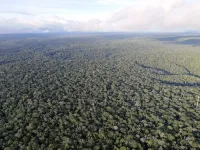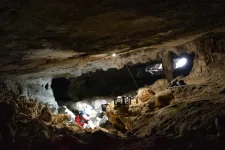(Press-News.org) Mulching is a possible management method for forest meadows and is important to their upkeep. During the process, the meadow is cut and the cuttings are shredded and left on the meadow. Despite its significance, the effects of this method on insects living in this habitat has rarely been studied up to now. Dr. Maria M. Georgi of the team working with the head of the University of Freiburg’s Chair of Nature Conservation and Landscape Ecology – Prof. Dr. Alexandra-Maria Klein, and her colleagues studied this in-depth. The result: Nearly all the mulching times examined had a negative impact on insect larvae and flower-visiting insects which are found on forest meadows. Georgi says, “Management is important for the maintenance of forest meadows. That is why we’re proposing alternative types of mulching be applied in future to improve conservation of the insects living there if no opportunity to apply another method, such as cut, is available.”
Meadows are important to the forest; mulching is important to the meadows
Forest meadows are often managed to attract game animals. This reduces their browsing of young plants – so the grazing of leaves and twigs – in the surrounding woods. Management is required to retain forest meadows. Otherwise, the forest would spread increasingly and the meadow would disappear. Compared to other methods, mulching is more effective in terms of cost and labor intensity. During the processes the meadow is mowed and the cuttings are shredded and left on the meadow. Although the impact of cut on plant and insect diversity has been intensively investigated, the opposite had been the case for mulching up to now.
Examining of four mulching times
The study was carried out at 24 locations in the northern Black Forest. The focus was on insect larvae and insect flower-visitors. The researchers examined how different mulching times affected these insects. Six locations were designated for a control group. They were not mulched. These were compared with six meadows that were mulched either in June or September, as well as six additional meadows that were mulched both in June and September. In terms of insect larvae, sawflies (Symphyta) accounted for 45 percent of the population studied, with butterflies (Lepidoptera) making up 44 percent. Hover files (Syrphidae) dominated the flower-visiting insects. They made up a share of 80 percent.
September mulching protects flower-visiting insects
For the insect larvae, all three mulching times studied had a negative impact on numbers compared to the control group. The findings were similar for the flower-visiting insects. Here, mulching in June, as well as mulching in June and September, had a negative impact on the number of insects counted. Yet September mulching had no impact in the case of flower-visitors. Georgi concludes, “On the basis of our results, we can recommend mulching in September in order to protect flower-visitors.”
Impacts on insect conservation
In a study published in November 2022, the researchers also investigated the impacts of mulching times on the nests of solitary bees and wasps that lived in cavities above ground. Mulching in June alone is best for their protection. Taken together, the results of both studies indicate no general recommendation can be made about mulching times. Conserving forest meadows is significant for the preservation of biological diversity and management of the surrounding forest. So meadow management is important, too. “Management with the aim of maintaining biological diversity should find a balance between plant and insect diversity,” says Georgi. “Insect-friendly mulching machines or using alternative times could be better ways to unite both objectives.”
Factual overview:
Original publication: Georgi, M. M., Gärtner, S. M., Förschler, M. I., Buse, J., Fornoff, F., Ssymank, A., Oelmann, Y., Klein, A.-M. (2023): Mulching time of forest meadows influences insect diversity. In: Insect Conservation and Diversity: 1- 11.
https://doi.org/10.1111/icad.12629
Dr. Maria M. Georgi prepared the study as a member of the team of the head of the University of Freiburg’s Chair of Nature Conservation and Landscape Ecology, Prof. Dr. Alexandra-Maria Klein, and the team of Dr. Veronika Braunisch at the research institute, the “Forstlichen Versuchs- und Forschungsanstalt (FVA) Baden-Württemberg” in Freiburg.
The work was done in cooperation with Dr. Stefanie Gärtner of the Black Forest National Park and Prof. Dr. Yvonne Oelmann of the University of Tübingen.
The study was supported by the FAZIT Foundation and the State Graduate Funding organization.
Contact:
University and Scientific Communications
University of Freiburg
Tel.: +49 761/203-4302
E-Mail: kommunikation@zv.uni-freiburg.de
END
Mulching time of forest meadows influences insect diversity
2023-03-01
ELSE PRESS RELEASES FROM THIS DATE:
Pseudomonas aeruginosa Bacteria produce a molecule that paralyzes immune system cells
2023-03-01
Bacteria of the species Pseudomonas aeruginosa are antibiotic-resistant hospital germs that can enter blood, lungs and other tissues through wounds and cause life-threatening infections. In a joint project, researchers from the Universities of Freiburg and Strasbourg in France have discovered a mechanism that likely contributes to the severity of P. aeruginosa infections. At the same time, it could be a target for future treatments. The results were recently appeared in the journal EMBO Reports.
Many bacterial species use sugar-binding molecules called lectins to attach to and invade host cells. Lectins can also influence the immune response to bacterial infections. However, these ...
Ice Age survivors
2023-03-01
The team analysed the genomes of 356 prehistoric hunter gatherers from different archaeological cultures – including new data sets of 116 individuals from 14 different European and Central Asian countries. Modern humans began to spread across Eurasia around 45,000 years ago but previous research showed that the first modern humans that arrived in Europe did not contribute to later populations. This study focuses on the people who lived between 35,000 and 5,000 years ago and that are, at least partially, the ancestors of the present-day population of Western Eurasia, including – for the first time – the genomes of people who lived during the Last Glacial Maximum (LGM), the ...
Deforestation in the tropics linked to a reduction in rainfall
2023-03-01
Projected deforestation in the Congo could result in a 12% reduction in rainfall
Study provides “compelling evidence” to protect forests
Deforestation is resulting in reduced rainfall across large parts of the tropics, according to new research.
People living in tropical forest communities have often complained that the climate gets hotter and drier once trees are cleared but until now, scientists have not been able to identify a clear link between the loss of tree cover and a decline in rainfall.
A research team at the University of Leeds combined satellite data of deforestation and rainfall to show ...
Quantum chemistry: Molecules caught tunneling
2023-03-01
Tunneling reactions in chemistry are very difficult to predict. The quantum mechanically exact description of chemical reactions with more than three particles is difficult, with more than four particles it is almost impossible. Theorists simulate these reactions with classical physics and must neglect quantum effects. But where is the limit of this classical description of chemical reactions, which can only provide approximations?
Roland Wester from the Department of Ion Physics and Applied Physics at the University of Innsbruck has long wanted to explore this frontier. “It requires an experiment that allows very precise measurements and ...
New study could help pinpoint hidden helium gas fields – and avert a global supply crisis
2023-03-01
Helium – essential for many medical and industrial processes – is in critically short supply worldwide. Production is also associated with significant carbon emissions, contributing to climate change.
This study provides a new concept in gas field formation to explain why, in rare places, helium accumulates naturally in high concentrations just beneath the Earth’s surface.
The findings could help locate new reservoirs of carbon-free helium – and potentially also hydrogen.
Research led by the University of Oxford could help overturn the current supply crisis of helium, ...
Unique alcohol avoidance program is associated with lower death rates
2023-03-01
A statewide alcohol-monitoring program that requires people arrested for drunk driving and other alcohol-involved offenses to be tested frequently for alcohol use can reduce the likelihood that participants die for several years after their involvement with the program, according to a new RAND Corporation study.
Analyzing results from South Dakota’s 24/7 Sobriety Program, researchers found that those arrested for drunk driving who participated in 24/7 Sobriety had on the order of a 50% lower risk of dying during the study period compared to those arrested for drunk driving who did not participate in the program..
The results are published in the latest edition of the ...
Outcomes of women undergoing coronary artery bypass surgery
2023-03-01
About The Study: The results of this study of more than 1.2 million patients indicate that women remain at significantly higher risk for adverse outcomes following coronary artery bypass grafting and no significant improvement has been seen over the course of the last decade. Further investigation into the determinants of operative outcomes in women is urgently needed.
Authors: Mario Gaudino, M.D., Ph.D., M.S.C.E., of Weill Cornell Medicine in New York, is the corresponding author.
To access the embargoed study: Visit our For The Media website at this link https://media.jamanetwork.com/
(doi:10.1001/jamasurg.2022.8156)
Editor’s Note: Please see the ...
Reexamining time from breast cancer diagnosis to surgery
2023-03-01
About The Study: This case series study using the data of 373,000 patients from the National Cancer Database found that time from breast cancer diagnosis to surgery of greater than eight weeks was associated with worse overall survival. Time to surgery of greater than eight weeks may partly be associated with disadvantageous social determinants of health.
Authors: Heather B. Neuman, M.D., of the University of Wisconsin School of Medicine and Public Health in Madison, is the corresponding author.
To access the embargoed study: Visit our For The Media website at this link https://media.jamanetwork.com/
(doi:10.1001/jamasurg.2022.8388)
Editor’s ...
Oldest human genome from southern Spain
2023-03-01
An international team of researchers has analysed ancient human DNA from several archaeological sites in Andalucía in southern Spain. The study reports on the oldest genome to date from Cueva del Malalmuerzo in southern Spain, as well as the 7,000 to 5,000-year-old genomes of early farmers from other well-known sites, such as Cueva de Ardales.
The Iberian Peninsula plays an important role in the reconstruction of human population history. As a geographic cul-de-sac in the southwest of Europe, it is on one hand considered a refuge during the last Ice Age with its drastic temperature fluctuations. On the other hand, it may have been one of the starting points for the recolonisation ...
The counting of nine billion trees could help manage climate credits and nature restoration
2023-03-01
Researchers from the University of Copenhagen and NASA have developed a method that has now mapped several billion trees and their carbon uptake in Africa’s Sahel region. In the future, the method could be used to monitor whether climate credit purchases have a positive effect on the number of trees and whether nature restoration is working.
The purchase of indulgences for CO2 emissions is gaining steam among global corporations. Carbon offset credits allow companies to emit a given amount of CO2 in exchange for the greenhouse gas being neutralized elsewhere, in the form of trees planted or left unfelled.
But with billions upon billions of trees across the planet, keeping track ...





